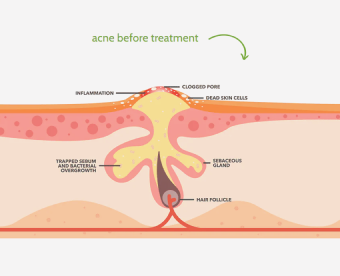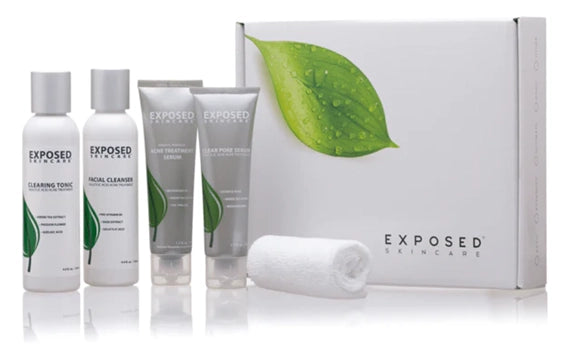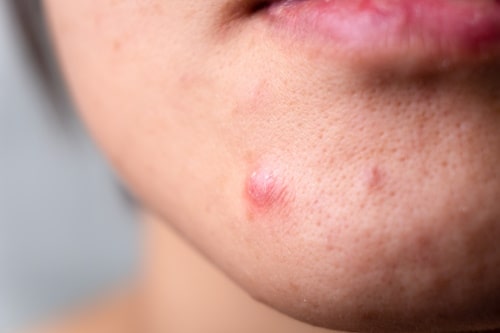As we delve into the world of skincare, we often encounter numerous ingredients promising miracles for our skin. One such ingredient that has been making waves in the skincare industry is lactic acid. Many beauty enthusiasts are increasingly embracing the potential of lactic acid for acne and other skin concerns.
In this blog, we will explore the dynamic role of lactic acid in combating acne, improving skin texture and tone, and its safe usage. Let's decode the secrets of this powerful skincare ingredient.
Also read: How to choose the best acne treatment
Biggest Take-Aways:
-
Lactic acid, a gentle yet effective exfoliant, is beneficial for acne treatment as it promotes cell turnover and unclogs pores.
-
While salicylic acid penetrates deeply into the pores and is suitable for oily skin, lactic acid provides a more hydrating and less irritating alternative, especially for dry and sensitive skin.
-
Using lactic acid safely involves gradual introduction, diligent sun protection, and performing a patch test to avoid potential irritation.
-
Exposed Skin Care offers comprehensive acne solutions, enriched with chemical exfoliants and Vitamin C, that hydrate the skin, brighten the complexion, and reduce the appearance of acne scars.

Lactic Acid: The Alpha in Skincare
Lactic acid, an alpha hydroxy acid (AHA), has gained popularity for its multifaceted role in skincare. Naturally found in certain foods and our bodies, lactic acid is a favorite among skincare enthusiasts due to its effectiveness and compatibility with various skin types.
What Makes Lactic Acid Stand Out?
Here's why you might want to consider adding lactic acid to your skincare routine:
-
Gentle Exfoliant: Lactic acid is a gentle chemical exfoliant, unlike physical exfoliants. It helps slough off dead skin cells from the skin's surface, resulting in a brighter complexion and smooth skin.
-
Hydration Provider: One of the hydrating ingredients, lactic acid, helps retain moisture in the skin, making it an excellent choice for dry skin types.
-
Dark Spot Diminisher: Lactic acid helps improve skin tone by reducing the appearance of dark spots and post-inflammatory hyperpigmentation.
-
Fine Lines and Wrinkles Eraser: By stimulating collagen production, lactic acid can reduce the appearance of fine lines and wrinkles, keeping your skin firm and youthful.
How Lactic Acid Works Against Acne
Lactic acid for acne has proven beneficial due to its exfoliating and hydrating properties. Acne occurs when hair follicles become clogged with oil, dead skin cells, and bacteria. By promoting cell turnover and removing the top layer of dull skin cells, lactic acid helps in unclogging pores, reducing the chances of acne development.
In contrast to other acids, such as salicylic acid and glycolic acid, lactic acid is less irritating and more hydrating, making it suitable even for sensitive skin. For those with acne-prone skin, lactic acid products can be a gentle yet effective addition to the skincare routine.
Lactic Acid Vs. Other Acids: An In-depth Comparison
In the realm of skincare, we often hear about alpha hydroxy acids, beta hydroxy acids, and various specific acids like salicylic acid, glycolic acid, and hyaluronic acid.

Here's a quick rundown of how lactic acid stands against these common skincare acids:
Lactic Acid Vs. Salicylic Acid
Both lactic acid and salicylic acid can be beneficial for acne treatment. Salicylic acid, a beta hydroxy acid, penetrates deeply into the pores, removing excess oil and dead skin cells, making it effective for oily skin and enlarged pores.
On the other hand, lactic acid, an alpha hydroxy acid, works on the skin's surface, making it a more gentle option. Its hydrating properties can be a boon for dry and sensitive skin types while still effectively managing acne.
Lactic Acid Vs. Glycolic Acid
Glycolic acid, another AHA, is derived from sugar cane and has smaller molecules than lactic acid. This means it penetrates the skin more deeply and quickly, which can be more effective but also potentially more irritating, especially for sensitive skin.
Lactic acid has larger molecules, meaning it doesn't penetrate the skin as deeply, reducing the chances of causing irritation. Therefore, lactic acid is often preferred by those with sensitive skin.
Lactic Acid Vs. Hyaluronic Acid
Hyaluronic acid is not an exfoliant but a powerful humectant that pulls moisture into the skin. Combining lactic acid with hyaluronic acid in your skincare routine can help balance exfoliation and hydration.
Using Lactic Acid Safely for Acne
Lactic acid can be a game-changer for your skin, but as with all skincare products, it's essential to use lactic acid safely.
Gradually Introduce Lactic Acid
When you first add lactic acid to your skincare routine, start by using it once or twice a week, then gradually increase the frequency as your skin adapts. Overuse can lead to red skin and increased sun sensitivity.
Sun Protection is a Must
Using lactic acid can make your skin more susceptible to sun damage. Always apply broad-spectrum sunscreen during the day to protect your skin from harmful UV rays.

Perform a Patch Test
Perform a patch test before fully incorporating any new skincare product into your routine. Apply a small amount of the lactic acid product on a discreet area of your skin and wait for 24 hours to see if any irritation or reaction occurs.
Lactic Acid Products to Consider
You can find lactic acid in various skincare products, from cleansers and toners to serums and masks. Depending on your skin type and concerns, you can choose a lactic acid-based product that suits your needs. Whether you're dealing with acne, dull skin, fine lines, or uneven skin tone, there's a lactic acid product out there for you.
The Benefits of Using Exposed Skin Care for Acne Management
Exposed Skin Care, a renowned skincare brand, offers comprehensive solutions to combat acne effectively.
The carefully crafted products pack a myriad of benefits for those battling stubborn acne:
-
Chemical Exfoliants: Exposed Skin Care products are rich in effective chemical exfoliants that help in clearing dead skin cells, unclogging pores, and paving the way to smoother, healthier skin.
-
Hydration for Dry Skin: The products provide ample hydration, ensuring that dry skin gets the necessary moisture it needs. This helps maintain a balanced skin environment that is not conducive to acne formation.
-
Vitamin C Enrichment: These products are formulated with Vitamin C, a potent antioxidant that can help brighten the skin and reduce the appearance of age spots and acne scars.
-
Comprehensive Skin Care: From cleansers and toners to serums and masks, Exposed Skin Care offers a complete range of skincare products that cater to the various needs of your skin.
Current research suggests that a holistic approach like this, which addresses all aspects of skin health, is most effective in managing acne. Opting for Exposed Skin Care can be a game-changing decision for your skin.
Conclusion
Navigating the world of acne treatments can be overwhelming, but understanding the potent power of lactic acid provides a promising avenue. Its exfoliating properties, capacity to boost cell turnover, and unclog pores make it a compelling ally against acne.
However, like all skincare, mindful use is essential. Gradual introduction, sun protection, and patch testing are key to a safe lactic acid skincare routine. Exposed Skin Care offers a robust selection of products for those seeking a comprehensive approach.
These are enriched with beneficial ingredients such as chemical exfoliants and vitamin C, designed to hydrate, illuminate, and support overall skin health. Patience and consistency are the golden rules in the quest for clearer skin.
Remember, every skin journey is unique, and your skin, being your most significant accessory, deserves only the best. Stay sun-safe and hydrated, dedicated to your skin care, and you'll soon be on your way to achieving the skin of your dreams. Happy skincare journey!
H2: FAQs About Lactic Acid for Acne
As you embark on your journey of using lactic acid for acne, you might have some questions. Here are some commonly asked questions about lactic acid:
Q: Is lactic acid good for acne?
Yes, lactic acid can be effective in treating acne. It helps exfoliate the skin, remove dead skin cells, and unclog pores, thus reducing the chances of acne breakouts.
Q: Is lactic or salicylic acid better for acne?
Both acids can be beneficial for acne. Salicylic acid, being oil-soluble, penetrates deeper into the pores, making it suitable for oily and acne-prone skin. Lactic acid, being more hydrating and less irritating, can be a better choice for dry and sensitive skin.
Q: What happens if you put lactic acid on a pimple?
Lactic acid can help exfoliate the skin around the pimple and unclog pores, which can aid in reducing the size and redness of the pimple.
Q: How long does lactic acid take to work for acne?
The effects of lactic acid on acne can be seen in a few weeks, but it varies depending on the individual's skin type and the severity of the acne. Consistent use of lactic acid products will yield the best results.
















